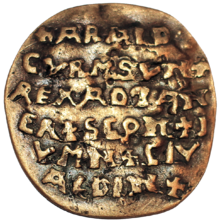
Harald Sinezubiy's disc ( Gormsson Disc ; English Curmsun Disc ) is a concave gold disc weighing 25.23 grams and 4.5 cm in diameter. Danish King Harald I Sinezuby (died in 986) is mentioned in the inscription on this disc. This discovery gained fame in 2014.
Detection
It is reported that Harald Sinezubiy's Disk is part of a Viking-era treasure found in the crypt of the destroyed church in Gross-Vekkov (after ) in Pomerania (now part of the Commune , Poland ), east of the river bank. Dieven (now Dzivna Strait) and not far from the place where between the 960 and 1043 years could be the legendary Viking stronghold in Jomsborg . The discovery was made by a certain Heinrich [1] .
After 1841, the disk was left in the crypt, and it was unknown about him until 1945, when the major of the Polish army, Stefan Silski, and his brother Michal entered the crypt and took everything that was there.
The uncleaned disc did not look like a gold one, so it was stored in a box with old buttons. However, in 2014, the 11-year-old great-granddaughter of Michal Silskij May Silska (Maja Sielska) found the disc and showed it to her history teacher. It was in Malmo , Sweden, where the family lived. The discovery of the disk was announced in the press on December 5, 2014 [2] .
According to other sources, the Silskys family originally received this disc in 1946 in the city of Volin [2] .
Research
Researchers read the inscription on the obverse as “ + ARALD CVRMSVN + REX AD TANER + SCON + JVMN + CIV ALDIN + ” [3] .
Translated, this means: " Harald Gormson, King of the Danes, Scania, Jomsne (Jumne), the city of Aldinburg [4] ." The reverse of Harald Sinezubiy's disk shows an equilateral cross .
According to the theory of the Swedish archaeologist Sven Rosborn, the disc may have been created by a Frankish monk in connection with the death of Harald around 986 in Jomsborg (Jumne). According to this theory, Harald could have been buried in the church in Viikovo, which was located near Jomsborg (Yumna).
Sven Rosborn writes:
“According to the language during the life of Harald, the inscription CIV + ALDIN should be associated with the previous name of the city (Jomsborg). Then the translation should look like this: "Yumna (Jomsborg) in the bishopric of Oldenburg." In the end, Yumna, according to Adam of Bremen , was the site of King Harald’s death. Therefore, the ending of the inscription should, from a Christian point of view, indicate exactly where Yumna was ” [3] .
Dating
Various scientists date the disc about 960-986 years.
The disk underwent electron microscopic analysis at Lund University in Sweden . He showed that the gold content is in the range of 83.3–92.8%. The surface and fusion showed characteristics that are common to artifacts created during the latter part of the Early Middle Ages . No trace of modern processes or chemicals was found [5] .
Location
Currently the disc is in a bank vault in Sweden. The insured value of the disc is 3.5 million US dollars. The evaluation was performed by Joni Westling, an expert appointed by the Swedish Chamber of Commerce and Lloyds / Brookfield Underwriting. It is expected that in the future the disc will be handed over to the museum or to a private collector.
Notes
- ↑ The Curmsun Disc website - The Story
- ↑ 1 2 Zyśk Daniel . Polish Press Agency . Science and Scholarship, 2014.
- ↑ 1 2 Rosborn Sven . A unique object from Harald Bluetooth´s time? . Malmö: Pilemedia, P. 4—5, 2015.
- ↑ Modern Oldenburg-in-Holstein .
- ↑ The Curmsun Disc website - Metallurgical Analysis
Literature
- Pontus Weman Tell (2016), The Curmsun Disc - Harald Bluetooth´s Golden Seal? www.academia.edu